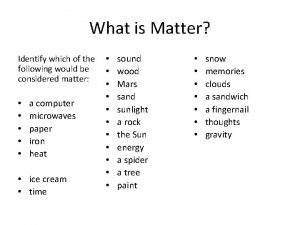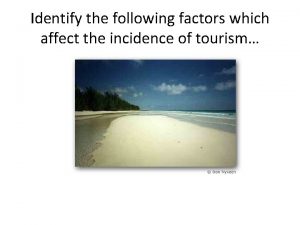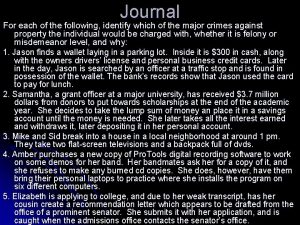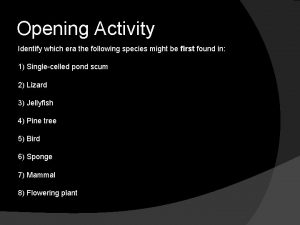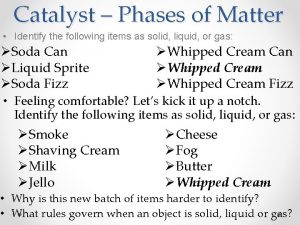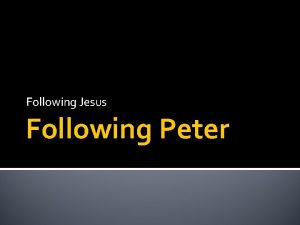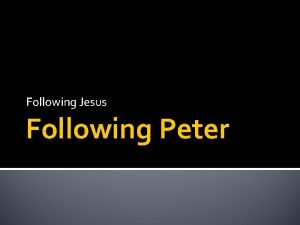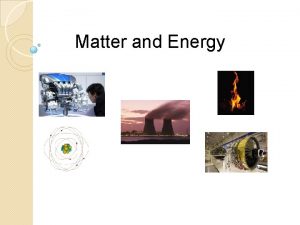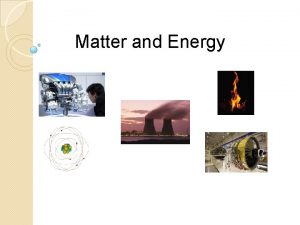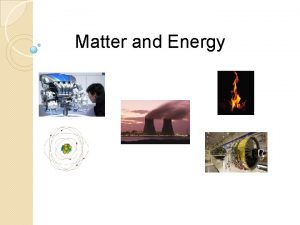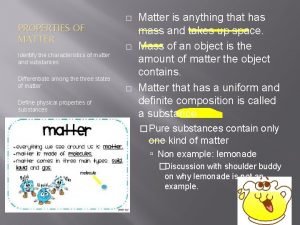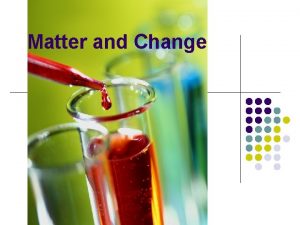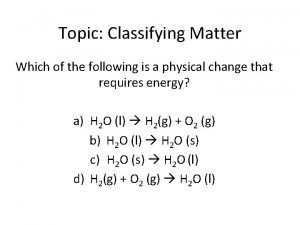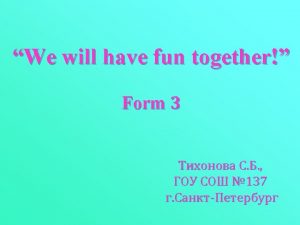What is Matter Identify which of the following
























- Slides: 24

What is Matter? Identify which of the following would be considered matter: • • • a computer microwaves paper iron heat • ice cream • time • • • sound wood Mars sand sunlight a rock the Sun energy a spider a tree paint • • snow memories clouds a sandwich a fingernail thoughts gravity

What is Matter? Identify which of the following would be considered • matter: • • • • a computer microwaves paper iron heat ice cream time sound wood Mars sand Sunlight • a rock • • • the Sun energy a spider a tree paint snow memories clouds a sandwich a fingernail thoughts gravity Matter = 16 , non-matter = 9

Other Definitions What are elements? • An element is a pure substance that is made up of only one kind of atom. What are atoms? • Atoms are the smallest unit of an element that maintains the identity of that element. What are compounds? • A compound is a substance made up of two or more elements that are chemically bonded.

Properties of Matter Properties of matter can be divided into two categories: A physical property can be observed or measured without changing the identity of the substance. A chemical property describes the ability of a substance to undergo changes and turn into another substance. It changes the chemical identity of the substance.

Some examples of Physical Properties: • • • Melting point Boiling point Brittleness Color Solubility (can it dissolve? )

Some examples of Chemical Properties: • • Reactive Flammable Explosive Toxicity

Changes in Matter Changes in matter can be divided into two categories: A physical change is a change in a substance that does not change the identity of the substance. A chemical change is a change in which one or more substances are converted into different substances with a new chemical identity. A chemical change is also called a chemical reaction.

States of Matter • There are four states of Matter: – Solid – Liquid – Gas – Plasma Any change in state (phase change) is a physical change since the chemical identity is untouched

States of Matter • States of matter on the molecular level

States of Matter : important properties Property Solid Liquid Gas Shape Definite Indefinite Volume Definite Indefinite Expansion upon Heating Very slight/none Moderate Great Compressibility Minimal affect Easily compressed with pressure Appearance of Particles are closely packed, rotate from a fixed position Attraction of particles, allow for them to touch but able to “flow”. Particles are far apart with little/no attraction.

Classification of Matter • Pure Substance- definite composition and cannot be easily separated. • Mixture- blend of two or more substances that can be separated by physical means (size, solubility, boiling point, etc. )

Classification of Matter • Pure Substance– Elements – Compounds • Mixtures– Homogeneous (uniform throughout) – Heterogeneous ( non-uniform, distinct phase)

Classification of Matter 1. Yes Can it be separated? 2. 3. Is the composition uniform? No Yes 4. No 5. Can it be decomposed by ordinary means? No Yes 7. 6. 1. 1. 2. 2. 3. 3. 4. 4.

1. Yes 2. Matter Can it be separated? Mixture Is the composition uniform? No Yes 4. 3. 5. No Pure Substance Can it be decomposed by ordinary means? No Yes 7. 6. 1. 1. 2. 2. 3. 3. 4. 4.

1. Yes 2. Matter Can it be physically separated? Mixture Is the composition uniform? No Yes Homogeneous 3. Heterogeneous No Pure Substance Can it be decomposed by ordinary means? No Yes Compound Element 1. 1. 2. 2. 3. 3. 4. 4.

Know your Elements! 1. Elements are the simplest form of matter. 2. Elements are the building blocks of all substances and cannot be easily divided into smaller subunits by ordinary chemical processes. 3. Elements are organized by atomic number on the periodic table. 4. Elements are identified by their symbols.

Elements & Symbols • The symbol of an element is often taken from its name. • The first letter is always capitalized. • If an element starts with the same letter as another element, sometime the first two letters are used. • The second letter is always lowercase. • Some elements have symbols that don’t match the name of the element because their name comes from another language. • element song

Groups – vertical columns, #1 -18, elements within the same group have similar chemical properties. Periods – horizontal rows

Elements & Symbols • • • Hydrogen Carbon Sodium Nitrogen Oxygen Fluorine Helium Lead Chlorine Magnesium

Elements & Symbols Hydrogen H Carbon C Sodium Na Nitrogen N Oxygen O Fluorine F Helium He Lead Pb Chlorine Cl Magnesium Mg

Elements & Symbols • • • Potassium Sulfur Copper Silver Gold Iron Nickel Zinc Aluminum Calcium

Elements & Symbols Potassium K Sulfur S Copper Cu Silver Ag Gold Au Iron Fe Nickel Ni Zinc Zn Aluminum Al Calcium Ca

What are Compounds? 1. Compounds are substances that are made up of two or more types of atoms. 2. Atoms in a compound are held together by chemical bonds. 3. Compounds can be broken into simpler substance through chemical processes. 4. Compounds are described using chemical formulas. The symbols tell what element and the subscript tells us how many. Some examples of common compounds include: Water – H 2 O , Carbon Dioxide CO 2, Sugar – C 12 H 22 O 11 5.

Common compounds Name Formula Water H 2 O Carbon Dioxide CO 2 Sugar C 12 H 22 O 11 Sodium Chloride Na. Cl Ammonia NH 3 Hydrogen Peroxide H 2 O 2 Methane CH 4
 Identify which is matter
Identify which is matter Classification of matter section 1 composition of matter
Classification of matter section 1 composition of matter Whats gray matter
Whats gray matter Section 1 composition of matter
Section 1 composition of matter Chapter 2 section 1 classifying matter answer key
Chapter 2 section 1 classifying matter answer key Optic tract
Optic tract Composition of matter section 1
Composition of matter section 1 Gray matter and white matter
Gray matter and white matter What is grey matter
What is grey matter Ecological succession
Ecological succession Hình ảnh bộ gõ cơ thể búng tay
Hình ảnh bộ gõ cơ thể búng tay Frameset trong html5
Frameset trong html5 Bổ thể
Bổ thể Tỉ lệ cơ thể trẻ em
Tỉ lệ cơ thể trẻ em Voi kéo gỗ như thế nào
Voi kéo gỗ như thế nào Glasgow thang điểm
Glasgow thang điểm Hát lên người ơi
Hát lên người ơi Môn thể thao bắt đầu bằng chữ f
Môn thể thao bắt đầu bằng chữ f Thế nào là hệ số cao nhất
Thế nào là hệ số cao nhất Các châu lục và đại dương trên thế giới
Các châu lục và đại dương trên thế giới Công thức tiính động năng
Công thức tiính động năng Trời xanh đây là của chúng ta thể thơ
Trời xanh đây là của chúng ta thể thơ Cách giải mật thư tọa độ
Cách giải mật thư tọa độ Phép trừ bù
Phép trừ bù Phản ứng thế ankan
Phản ứng thế ankan
